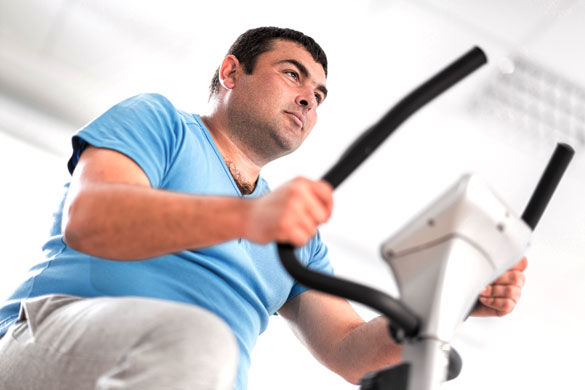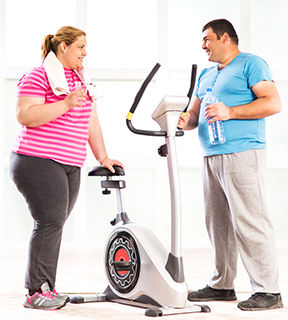
For the past few years, high-intensity interval training (HIIT) has been one of the biggest fitness trends worldwide. Long a staple of training regimens of athletes and fitness enthusiasts, in the past 10 years HIIT has been shown to be both safe and effective for people with a wide range of health challenges, including diabetes, cardiovascular disease, heart failure and obesity.
As a health and fitness professional, you undoubtedly encounter clients with a similar range of challenges, particularly obesity. Although you know how effective HIIT can be for your performance-focused clients, you may not have considered implementing it with clients who struggle with obesity. After all, HIIT is a challenging format even for highly fit clients, let alone those who may have been previously sedentary and are dealing with the challenges that come with extra weight, such as excessive joint stress or increased risk for a cardiovascular event. Furthermore, you may assume that clients with obesity are less likely to stick with a program involving HIIT due to the more extreme feelings of discomfort and fatigue typically experienced during a HIIT session compared to steady-state exercise. This article presents sufficient evidence to help you move past these concerns, and provides practical tips for programming that makes it possible for you to tap into the powerful effects of HIIT when working with clients struggling with obesity.
Can Clients With Obesity Safely Perform HIIT?
Many recent studies can help us answer this question. A study published in the Journal of Strength and Conditioning Research (Sawyer et al., 2015), for example, tested a highly intense method of maximal oxygen uptake (VO2max) testing in subjects with obesity. This testing methodology, known as the verification test, involves a standard maximal exercise test that gradually increases work rate on a cycle ergometer until exhaustion. This is followed by 10 minutes of active recovery and finishes with another bout of exercise to exhaustion at the same work rate at which subjects finished the first test. While the verification test is becoming the accepted standard in VO2max testing (Poole and Jones, 2017), only one other published study used this test in subjects with obesity. The study showed that approximately 70% of the subjects achieved a VO2max at least 2% higher during the second test. Furthermore, there were no adverse events and, among the 21 subjects tested, only one opted out of the verification test.
Another study, which was presented at the American College of Sports Medicine Conference in May 2017, had 10 obese men perform six exhaustive exercise bouts on a cycle ergometer. These bouts included a standard incremental VO2max test, four verification phase tests ranging from 80% to 105% of the maximal work rate from the incremental test, and a three-minute all-out exercise test. Of the 60 exhaustive exercise bouts in that study, zero adverse events occurred. Another study involving the use of treadmills (instead of a cycle ergometer) with overweight and obese subjects had similar results (Wood et al., 2010).
Clearly, these studies demonstrate that people with obesity can do very intense acute bouts of exercise eliciting maximal heart rate and oxygen uptake without experiencing adverse events. While these studies did not focus specifically on HIIT, results from two other recent studies shed some light on the ability of people with obesity to participate in a HIIT program.
In a study published in the Journal of Applied Physiology, 22 previously sedentary adults with obesity were randomly assigned to either eight weeks of HIIT or steady-state, moderate-intensity cycle ergometer exercise. All of the subjects, who ranged in age from 18 to 47 years, were unaccustomed to exercise, had an average body mass index (BMI) of 36, and an average body fat percentage of 46%. All subjects exercised three days per week at either 75% of maximal heart rate in the moderate group or they completed 10 one-minute intervals eliciting 90 to 95% of maximal heart rate separated by one-minute active-recovery periods in the HIIT group. Of the 22 subjects who began the study, two dropped out of each group due to time constraints. Researchers did not observe any adverse effects of the HIIT training. However, the study clearly showed powerful increases in aerobic fitness and artery health in both groups (Sawyer et al., 2016).
In a similar study, researchers compared 10 weeks of HIIT, moderate-intensity, steady-state exercise, and resistance training in obese adults. Of the 14 subjects in the HIIT group, all completed the study without exhibiting adverse effects, and all improved their cardiovascular health to a greater extent than the other groups (Schjerve et al., 2008).
In both of these studies, the HIIT groups exercised for approximately 25% less time than the comparison groups. The results of these two studies, along with others, demonstrate that people with obesity can safely and successfully undergo a HIIT program and, importantly, realize significant improvements in fitness and cardiovascular health in less time than if they were to perform steady-state exercise. Admittedly, these are short-term studies and, due to the lack of research in this population, long-term efficacy is still unknown.
The Enjoyment Factor
 Another important question must be answered: “Will people with obesity enjoy HIIT?” Here’s what the research has to say.
Another important question must be answered: “Will people with obesity enjoy HIIT?” Here’s what the research has to say.
A 2011 study that focused on active, lean subjects showed that HIIT was rated as more enjoyable than continuous exercise (Bartlett et al., 2011). Likewise, the training study discussed earlier, which focused on previously sedentary adults with obesity, found no difference in enjoyment between the continuous exercise group and the HIIT group (Sawyer et al., 2016).
Another recent study tried to answer this question by measuring the subjects’ enjoyment and mood during and after exercise. The researchers had 21 overweight and obese subjects who were insufficiently active complete four bouts of exercise on different days. The bouts of exercise included one continuous bout of high-intensity exercise and three different interval bouts of either 30-, 60- or 120-second duration. They found that participants felt more negatively about the exercise the longer it lasted, as they felt more positive after the 30- and 60-second interval trials compared to the 120-second interval and continuous trials (Martinez et al., 2015).
In summary, the results of these studies show that HIIT can be just as enjoyable—if not more enjoyable—than continuous exercise in people with obesity who are not accustomed to exercise.
More Support for Using HIIT With Clients
The latest American College os Sports Medicine (ACSM, 2018) guidelines open up a host of opportunities for obese individuals to engage in exercise without the barrier of having to undergo a medical exam. Under the previous guidelines, obesity was considered a risk factor, which meant that only one other risk factor was needed to disqualify an individual from starting a vigorous-intensity exercise program without physician approval (ACSM, 2014). The latest guidelines, however have done away with risk-factor screening because cardiovascular events are extremely rare during exercise, risk factors are not good predictors of exercise induced cardiovascular events, and risk factor screening was leading to unnecessary physician visits (American College of Sports Medicine, 2018).
Furthermore, the latest guidelines make no mention of obesity. Individuals with obesity are treated just like individuals who have a normal BMI. The new pre-exercise recommendations are centered on three things:
- The presence of disease or symptoms of disease
- The desired intensity of exercise
- The current physical-activity level of the individual
The second portion of the pre-exercise screening involves the desired intensity of exercise. Because we are talking about HIIT, the intensity will be vigorous.
Perhaps the most important factor to consider is the current physical-activity level of the client. If you have a client who is completely sedentary to begin with, you do not want to start them with vigorous or high-intensity exercise. It is essential that an individual is accustomed to regular exercise before participating in vigorous exercise, including HIIT. This means if your client begins as a sedentary individual, he or she should start with consistent light-to-moderate exercise for the first two to four weeks (at a minimum) before incorporating HIIT. This slow progression to HIIT for those unaccustomed to high-intensity exercise is most likely the best way to ensure program adherence and avoid overuse injuries. Conversely, if your client struggles with obesity but is a regular exerciser, he or she may be ready to start vigorous exercise, including HIIT.
In summary, while the current guidelines for exercise testing and prescription no longer present a barrier for incorporating HIIT into the programs of clients with obesity, it is essential that sedentary individuals gradually increase exercise participation before partaking in HIIT.
Practical Programming Tips
Finally, here are a few important tips to keep in mind when designing an exercise program involving HIIT for individuals with obesity. It is important to remember that each client is unique and, as such, you should avoid applying a one-size-fits-all approach. The following guidelines can help increase your clients’ chances of success and level of enjoyment:
- Consider low-impact modes of exercise like riding a stationary bicycle instead of walking or jogging in individuals with obesity, especially those with a history of lower-extremity orthopedic injuries.
- HIIT is based on relative heart rate, so, if possible, it is best to conduct a pre-exercise submaximal or maximal exercise test to obtain an estimate of your client’s maximal heart rate. When your client envisions HIIT, he or she may picture an athlete running at 8 mph up an incline, but when properly using relative heart rate in an obese client of a lower fitness level, the absolute intensity will be much lower. You may find, for example, that your client achieves 90 to 95% of maximal heart rate by walking up an incline or with a workload on the bike that is much lower than you would expect.
- Slowly incorporating HIIT into a more standard cardiovascular fitness program is the most effective and sustainable method. Start by removing one day of steady-state exercise and replacing it with HIIT. After a couple of weeks, increase to two days per week of HIIT and three days per week of steady-state exercise. Use caution when considering using more than two or three days per week of HIIT in an exercise program for cardiovascular fitness and health (even for highly fit clients). Taking sufficient time to recover between high-intensity workouts is essential, which is why it’s always best to vary the workouts and have a couple days of steady-state exercise mixed in with a couple days of HIIT.
- Interval length is an important factor in the enjoyment of HIIT (Martinez et al., 2015). Thus, one-minute work intervals alternated with one minute of recovery may be ideal and has been shown to be very effective. Also, you can gradually increase the dose of HIIT by starting with just five one-minute intervals, and adding one to two intervals each week until 10 or more intervals can be completed. Because the long-term sustainability of HIIT interventions in individuals with obesity is still unknown, start out slowly and gradually increase the HIIT dose by increasing the number of intervals and the number of high-intensity sessions performed in a week (but not more than two or three).
Summary
In summary, HIIT has been shown to be a time-effective strategy for improving fitness and health outcomes in individuals with obesity. Your clients who struggle with obesity can successfully and safely perform exhausting, high-intensity exercise and they might even enjoy it just as much or more than traditional steady-state exercise. The newest industry guidelines have opened the door for obese individuals to engage in vigorous exercise, including HIIT, so now is the time to consider using HIIT in your exercise programming with clients with obesity so they, too, can begin realizing the dramatic benefits of this novel form of exercise.
References
American College of Sports Medicine (2018). ACSM's Guidelines for Exercise Testing and Prescription (10th ed.). Wolters Kluwer/Lippincott Williams & Wilkins Health.
American College of Sports Medicine (2014). ACSM's Guidelines for Exercise Testing and Prescription (9th ed.). Wolters Kluwer/Lippincott Williams & Wilkins Health.
Bartlett, J.D. et al. (2011). High-intensity interval running is perceived to be more enjoyable than moderate intensity continuous exercise: Implications for exercise adherence. Journal of Sports Sciences, 29, 547–553.
Martinez, N. et al. (2015). Affective and enjoyment responses to high-intensity interval training in overweight-to-obese and insufficiently active adults. Journal of Sport and Exercise Psychology, 37, 138–149
Poole, D.C. and Jones, A.M. (2017). CORP: Measurement of the maximum oxygen uptake (VO2max):VO2peak is no longer acceptable. Journal of Applied Physiology.
Riebe, D. et al. (2015). Updating ACSM’s recommendations for exercise pre-participation health screening. Medicine & Science in Sports & Exercise, 47, 2473–2479.
Sawyer, B.J. et al. (2015) Using a verification test for determination of VO2max in sedentary adults with obesity. Journal of Strength and Conditioning Research, 29, 3432–3438.
Schjerve, I.E. et al. (2008) Both aerobic endurance and strength training programs improve cardiovascular health in obese adults. Clinical Science, 115, 283–293.
Wood, R.E. et al. (2010) VO2max in overweight and obese adults: Do they meet the threshold criteria? Medicine & Science in Sports & Exercise, 42, 470–477.





 by
by 

 Another important question must be answered: “Will people with obesity enjoy HIIT?” Here’s what the research has to say.
Another important question must be answered: “Will people with obesity enjoy HIIT?” Here’s what the research has to say.



